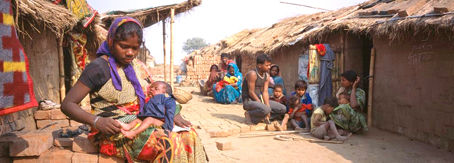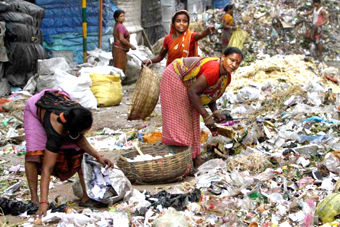சமூகப் பொருளாதார சாதிவாரிக் கணக்கெடுப்பு: தீவிரமடையும் வறுமைக்குத் தீர்வு என்ன?
இந்தியா வேகமாக முன்னேறுகிறது; அமெரிக்காவுக்கும் சீனாவுக்கும் அடுத்த நிலையில் உள்ள இந்தியா வல்லரசாகப் போகிறது என்றெல்லாம் ஆட்சியாளர்கள் வாப்பந்தல் போட்டாலும் உண்மை நிலை வேறாக இருக்கிறது. 1947 போலி சுதந்திரத்துக்குப் பின்னரும் கிராமப்புறங்களில் குறிப்பிடும்படியான வளர்ச்சி எதுவுமில்லை; இன்னமும் வறுமையிலும் ஒடுக்கப்பட்ட நிலையிலும்தான் கிராமப்புற மக்கள் வாழ்கின்றனர். – இந்த உண்மைகளை அண்மையில் வெளியிடப்பட்டுள்ள சமூக பொருளாதார சாதிவாரி கணக்கெடுப்பு மெய்ப்பித்துக் காட்டியுள்ளது.

கடந்த 2011 முதலாக நாடு தழுவிய அளவில் மேற்கொள்ளப்பட்ட சமூக பொருளாதார மற்றும் சாதிவாரி கணக்கெடுப்பு அறிக்கையின் ஒரு பகுதியை கடந்த ஜூன் 3-ம் தேதியன்று மைய அரசு வெளியிட்டுள்ளது. இந்தியாவில் காலனிய ஆட்சிக் காலத்தில் 1934-ம் ஆண்டில் சமுக பொருளாதார சாதிவாரியிலான கணக்கெடுப்பு நடத்தப்பட்ட பின்னர், நாடு முழுவதும் நடத்தப்பட்டுள்ள இந்த முதலாவது சமூக பொருளாதார சாதிவாரி கணக்கெடுப்பு, இந்திய மக்களின் அவலமான வாழ்க்கை நிலைமைகளை வெளிச்சம் போட்டுக் காட்டுவதாக உள்ளது.
ஐந்தாண்டு திட்டங்கள், ஊரக வளர்ச்சித் திட்டங்கள், மக்கள்நல மேம்பாட்டுத் திட்டங்கள், வறுமை ஒழிப்புத் திட்டங்கள் முதலான எவையும் நாட்டு மக்களின் வாழ்வில் எந்த முன்னேற்றத்தையும் கொண்டு வரவில்லை என்பதையே இந்தப் புள்ளிவிவரங்கள் உணர்த்துகின்றன. காந்தியம், போலி சோசலிசம், சமூக நீதி, இட ஒதுக்கீடு, தனியார்மய – தாராளமய – உலகமயமாக்கம் – என எல்லா கொள்கைகளும் தோற்றுப்போவிட்டதையே நாட்டு மக்களின் வாழ்க்கை நிலைகள் இடித்துரைக்கின்றன. ஆனால் ஆட்சியாளர்களோ, இந்தியாவில் வறுமை குறைந்து, வளம் பெருகி, வல்லரசாக வளர்ந்து கொண்டிருப்பதாகப் புள்ளவிவர சதவீதக் கணக்கு காட்டி சதிராடிக் கொண்டிருக்கின்றனர்.
இச்சமூக பொருளாதார சாதிவாரிக் கணக்கெடுப்பின் வாயிலாக அதிகாரத்தில் எந்தெந்த சாதிகளுக்கு எவ்வளவு பங்கு இருக்கிறது என்ற உண்மை வெளியாகி, அதனால் ஆதிக்க சாதிகளுக்கிடையே முரண்பாடும் மோதலும் வெடிக்கலாம் என்பதால் ஆளும் வர்க்கமும் பா.ஜ.க. அரசும் கிராமப்புற சமூக பொருளாதார நிலைமை பற்றிய விவரங்களை மட்டுமே வெளியிட்டுள்ளன. சாதிவாரிக் கணக்கெடுப்பின் விவரங்களை வெளியிடவில்லை. இதைக் கண்டிக்கும் சமூக நீதி பேசும் பல்வேறு ஓட்டுக் கட்சிகள், சாதிவாரிக் கணக்கெடுப்பின் அடிப்படையில் இதர பிற்பட்டோருக்கான இட ஒதுக்கீட்டு அளவை உயர்த்த வேண்டுமென்று கோருகின்றன. இதன் மூலம் இக்கட்சிகள் தமது வாக்கு வங்கியைத் தக்கவைத்துக் கொள்ள முயற்சிக்கின்றன தவிர, இக்கணக்கெடுப்பின் மூலம் அம்பலமாகியுள்ள நாட்டு மக்களின் சமூக பொருளாதார அவலநிலையை மாற்றியமைப்பதற்கான எந்த திட்டத்தையும் அவை முன்வைக்கவில்லை.

இக்கணக்கெடுப்பின்படி, இந்திய நாட்டில் கிராமப்புறம் மற்றும் நகர்ப்புறம் – என இரண்டையும் சேர்த்து மொத்தம் 24.39 கோடி குடும்பங்கள் வாழ்கின்றன. இதில் 17.91 கோடி – அதாவது 73 சதவீதக் குடும்பங்கள் கிராமப்புறங்களில் வசிக்கின்றன. கிராமங்களில் உள்ள 21.53 சதவீத குடும்பத்தினர் – அதாவது 3.86 கோடிப் பேர் தாழ்த்தப்பட்ட, பழங்குடியினத்தவராவர். இவர்களில் பெரும்பாலோருக்குச் சொந்தமான வீடு கூட இல்லாமல் தொடர்ந்து வறிய நிலையிலேயே இருத்தி வைக்கப்பட்டுள்ளனர்.
ஒட்டுமொத்தமாக, கிராமப்புறங்களிலுள்ள 49 சதவீத குடும்பங்கள் ஏழ்மை நிலையில் உள்ளன. கிராமப்புறத்தின் 10.69 கோடி குடும்பங்களுக்கு சொந்தமாகத் துண்டு நிலம்கூட இல்லை. தினக்கூலிகளாகப் பிழைப்பை நடத்தும் இவர்கள் குடிசை வீடுகளில் எவ்வித அடிப்படை வசதியும் இன்றி வாழ்கின்றனர். கிராமப்புறங்ககளில் வெறும் 3 சதவீத அளவிலான குடும்பங்களில் மட்டுமே, குடும்பத்தில் ஒருவர் பட்டப்படிப்பு படித்துள்ளனர். ‘ஒளிரும் குஜராத்’தில் 72 சதவீத குடும்பங்கள் மிகக் குறைந்த கல்வி பெற்றவர்களாகவே உள்ளனர்.
இதில் கொடுமையான விசயம் என்னவென்றால், நாட்டின் 4.08 லட்சம் குடும்பத்தினர் குப்பை சேகரித்து பிழைக்கின்றனர். 6.68 லட்சம் குடும்பங்கள் பிச்சை எடுத்துத்தான் வாழ்க்கையை ஓட்டுகின்றன. டெல்லியில் மட்டும் 3 லட்சம் பேர் குப்பை பொறுக்கிப் பிழைக்கின்றனர்.
தமிழ்நாட்டில் மொத்தமுள்ள 1 கோடியே 67 ஆயிரத்து 849 குடும்பங்களில் 42.47 சதவீதக் குடும்பங்கள் நகர்ப்புறங்களில் வசிக்கின்றனர். கிராமப் புறங்களில் 55.58 சதவீதக் குடும்பங்கள் வசிக்கின்றன. கிராமப்புறத்திலுள்ள 78.08 சதவீத குடும்பங்களில் அதிகம் சம்பாதிக்கும் உறுப்பினருக்கு ரூ. 5000 க்கும் குறைவாகத்தான் வருவாய் உள்ளது. இது தேசிய சராசரியான 74.5 சதவீதத்தை விட அதிகமாகும். குறைந்த வருமானம் ஈட்டும் குடும்பங்கள் அதிகமுள்ள மாநிலங்களின் பட்டியலில் தமிழகம் இந்தியாவில் ஐந்தாவது இடத்தில் இருக்கிறது. தமிழக கிராமங்களில் ஒட்டுமொத்தமாக 56 சதவீதக் குடும்பங்களுக்கு சொந்தமாக நிலம் இல்லை. இது தேசிய சராசரியான 38.27 சதவீதத்தை விட மிகவும் அதிகம். நிலமில்லாமல், கூலி வேலை செய்து பிழைக்க வேண்டிய நிலையிலுள்ள ஏழைகள் அதிகமான மாநிலங்களில் தமிழகம்தான் முதலிடம் வகிக்கிறது.
இந்தக் கணக்கெடுப்பின் முடிவுகள் வெளியான அதேநேரத்தில் , இந்தியாவில் பல லட்சம் டாலர் சொத்துக்களை உடைமையாகக் கொண்டுள்ள தனிநபர்களின் எண்ணிக்கை 2013-ல் 1.96 லட்சத்திலிருந்து 2014-ல் 2.5 லட்சமாக அதிகரித்துள்ளது என்று “வெல்த் எக்ஸ்” என்ற நிறுவனம் கடந்த ஜூன் 8 அன்று ஓர் அறிக்கையில் குறிப்பிட்டுள்ளது. “நியூ வேர்ல்டு வெல்த்” என்ற அமைப்பானது, புனே நகரில் மட்டும் பெரும் பணக்காரர்களின் எண்ணிக்கை 317 சதவீதம் அதிகரித்துள்ளதாகக் கூறுகிறது. 2014-ல் இந்தியாவில் 600 கோடிக்கு மேல் சொத்துக்களைக் கொண்டுள்ள பெரும் பணக்காரர்கள் 8595 பேர் என்றும், அவர்களின் ஒட்டுமொத்த சொத்து மதிப்பு ரூ 50 லட்சம் கோடி என்றும் அது குறிப்பிடுகிறது. கோடிக்கணக்கான விவசாயிகள், தொழிலாளர்கள், உழைக்கும் மக்களின் உழைப்பைக் கொடூரமாகச் சுரண்டி வாழ்வாதாரங்களை அவர்களிடமிருந்து பிடுங்கி, சமூக அடுக்கின் உச்சியிலுள்ள மேட்டுக்குடி கும்பலிடம் குவித்ததன் விளைவாக அம்பானி, மிட்டல், சாங்வி, அசிம் பிரேம்ஜி, பலோன்ஜி ஷபர்ஜி மிஸ்த்திரி ஆகிய ஐந்து பெரும் தரகு முதலாளிகளின் சொத்து மதிப்பு கடந்த ஆண்டில் 5,23,897 கோடி ரூபாயாக ஊதிப்பெருத்துள்ளது. இத்தகைய புள்ளிவிவரங்கள் மலைக்கும் மடுவுக்கான ஏற்றத்தாழ்வை வெளிச்சம் போட்டுக் காட்டுகின்றன.
இதை மேலும் தீவிரமாக்கும் வகையில், ஏற்கெனவே பட்ஜெட்டில் கிராமப்புற வளர்ச்சிக்கான ஒதுக்கீட்டைக் குறைத்துள்ளதோடு, ரூ 7,525 கோடிக்கு மறைமுக வரியை மோடி அரசு சாமானிய மக்களின் மீது திணித்துள்ளது. நாட்டின் கோடானுகோடி மக்கள் வறுமையில் பரிதவிக்கும்போது அவர்களுக்கான உணவுப் பாதுகாப்பை வழங்காமல், நேரடிப் பணப்பட்டுவாடா திட்டத்தின் மூலம் அவர்களைச் சந்தைச் சூதாட்டத்தில் சிக்க வைக்கிறது. அரிசி, மண்ணெண்ணெய் முதலான அத்தியாவசியப் பொருட்களுக்கான மானியம் அவர்களது வங்கிக் கணக்கில் போடப்படும் என்று இதற்காகவே ஆதார் அட்டை, ஸ்மார்ட் கார்டு திட்டங்களை மோடி அரசு திணித்துவருவதோடு, இதனை வளர்ச்சிக்கான பாதையாகச் சித்தரிக்கிறது.
இந்த ‘வளர்ச்சி’ யாருக்கானது என்பதை இந்தப் புள்ளி விவரங்களே காட்டும்போது, தனியார்மயம் – தாராளமயம் – உலகமயம் எனப்படும் இந்தப் பேரழிவுப் பாதையை அனைத்து ஓட்டுக் கட்சிகளும் ஒரே குரலில் ஆதரித்துக் கூப்பாடு போட்டுவருவது எத்தகையதொரு மோசடி!
– மனோகரன்
________________________________
புதிய ஜனநாயகம், ஆகஸ்ட் 2015
________________________________
